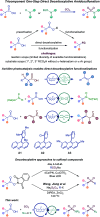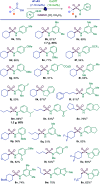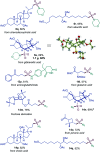Photocatalytic decarboxylative amidosulfonation enables direct transformation of carboxylic acids to sulfonamides
- PMID: 34084443
- PMCID: PMC8115300
- DOI: 10.1039/d1sc01389k
Photocatalytic decarboxylative amidosulfonation enables direct transformation of carboxylic acids to sulfonamides
Abstract
Sulfonamides feature prominently in organic synthesis, materials science and medicinal chemistry, where they play important roles as bioisosteric replacements of carboxylic acids and other carbonyls. Yet, a general synthetic platform for the direct conversion of carboxylic acids to a range of functionalized sulfonamides has remained elusive. Herein, we present a visible light-induced, dual catalytic platform that for the first time allows for a one-step access to sulfonamides and sulfonyl azides directly from carboxylic acids. The broad scope of the direct decarboxylative amidosulfonation (DDAS) platform is enabled by the efficient direct conversion of carboxylic acids to sulfinic acids that is catalyzed by acridine photocatalysts and interfaced with copper-catalyzed sulfur-nitrogen bond-forming cross-couplings with both electrophilic and nucleophilic reagents.
This journal is © The Royal Society of Chemistry.
Conflict of interest statement
There are no conflicts to declare.
Figures







Similar articles
-
Functional group divergence and the structural basis of acridine photocatalysis revealed by direct decarboxysulfonylation.Chem Sci. 2022 Mar 21;13(14):4170-4179. doi: 10.1039/d2sc00789d. eCollection 2022 Apr 6. Chem Sci. 2022. PMID: 35440976 Free PMC article.
-
Decarboxylative Triazolation Enables Direct Construction of Triazoles from Carboxylic Acids.JACS Au. 2023 Feb 16;3(3):813-822. doi: 10.1021/jacsau.2c00606. eCollection 2023 Mar 27. JACS Au. 2023. PMID: 37006773 Free PMC article.
-
Tricomponent Decarboxysulfonylative Cross-Coupling Facilitates Direct Construction of Aryl Sulfones and Reveals a Mechanistic Dualism in the Acridine/Copper Photocatalytic System.ACS Catal. 2022 Jul 15;12(14):8729-8739. doi: 10.1021/acscatal.2c02332. Epub 2022 Jul 6. ACS Catal. 2022. PMID: 36643936 Free PMC article.
-
Acridine Photocatalysis: Insights into the Mechanism and Development of a Dual-Catalytic Direct Decarboxylative Conjugate Addition.ACS Catal. 2020 Oct 2;10(19):11448-11457. doi: 10.1021/acscatal.0c03440. Epub 2020 Sep 9. ACS Catal. 2020. PMID: 36636662 Free PMC article.
-
Photocatalytic decarboxylation of free carboxylic acids and their functionalization.Chem Commun (Camb). 2024 Sep 5;60(72):9645-9658. doi: 10.1039/d4cc03189j. Chem Commun (Camb). 2024. PMID: 39120531 Review.
Cited by
-
Acridine/Lewis Acid Complexes as Powerful Photocatalysts: A Combined Experimental and Mechanistic Study.ACS Catal. 2024 Oct 4;14(19):14574-14585. doi: 10.1021/acscatal.4c04897. Epub 2024 Sep 16. ACS Catal. 2024. PMID: 39822273
-
Benzothiazole derivatives as inhibitors of chikungunya virus replicative cycle.Future Med Chem. 2025 May;17(10):1105-1117. doi: 10.1080/17568919.2025.2504337. Epub 2025 May 16. Future Med Chem. 2025. PMID: 40376715
-
Radical approaches to C-S bonds.Nat Rev Chem. 2023 Aug;7(8):573-589. doi: 10.1038/s41570-023-00505-x. Epub 2023 Jun 21. Nat Rev Chem. 2023. PMID: 37344618 Review.
-
Site-selective decarbonylative [4 + 2] annulation of carboxylic acids with terminal alkynes by C-C/C-H activation strategy and cluster catalysis.Chem Sci. 2024 Nov 14;15(48):20346-20354. doi: 10.1039/d4sc05429f. eCollection 2024 Dec 11. Chem Sci. 2024. PMID: 39574531 Free PMC article.
-
Decarboxylative Sulfinylation Enables a Direct, Metal-Free Access to Sulfoxides from Carboxylic Acids.Angew Chem Int Ed Engl. 2022 Oct 24;61(43):e202210525. doi: 10.1002/anie.202210525. Epub 2022 Sep 9. Angew Chem Int Ed Engl. 2022. PMID: 36006859 Free PMC article.
References
-
- The Chemistry of Sulphinic Acids, Esters and their Derivatives, ed. S. Patai, John Wiley & Sons, Ltd, New Jersey, 1990
- The Chemistry of Sulphonic Acids, Esters and their Derivatives, ed. S. Patai and Z. Rapport, John Wiley & Sons, New York, 1991
- Zhao X. Dimitrijević E. Dong V. M. J. Am. Chem. Soc. 2009;131:3466–3467. - PubMed
- Dornan P. K. Kou K. G. M. Houk K. N. Dong V. M. J. Am. Chem. Soc. 2014;136:291. - PMC - PubMed
- García-Domínguez A. Müller S. Nevado C. Angew. Chem., Int. Ed. 2017;56:9949–9952. - PubMed
- Burke E. G. Gold B. Hoang T. T. Raines R. T. Schomaker J. M. J. Am. Chem. Soc. 2017;139:8029–8037. - PMC - PubMed
- Nguyen V. T. Dang H. T. Pham H. H. Nguyen V. D. Flores-Hansen C. Arman H. D. Larionov O. V. J. Am. Chem. Soc. 2018;140:8434–8438. - PMC - PubMed
- Ratushnyy M. Kamenova M. Gevorgyan V. Chem. Sci. 2018;9:7193–7197. - PMC - PubMed
- Hell S. M. Meyer C. F. Misale A. Sap J. B. I. Christensen K. K. Willis M. C. Trabanco A. A. Gouverneur V. Angew. Chem., Int. Ed. 2020;59:11620–11626. - PMC - PubMed
- Nambo M. Tahara Y. Yim J. C.-H. Yokogawa D. Crudden C. M. Chem. Sci. 2021 doi: 10.1039/D1SC00133G. - DOI - PMC - PubMed
-
- Patani G. A. LaVoie E. J. Chem. Rev. 1996;96:3147–3176. - PubMed
- Metabolism, Pharmacokinetics and Toxicity of Functional Groups, ed. D. A. Smith, Royal Society of Chemistry: London, United Kingdom, 2010, pp. 99–167, 210–274
- Ilardi E. A. Vitaku E. Njardarson J. T. J. Med. Chem. 2014;57:2832–2842. - PubMed
- Scott K. A. Njardarson J. T. Top. Curr. Chem. 2018;376:5. - PubMed
-
- Friedman H. L., Influence of isosteric replacements upon biological activity, NAS-NRS, Washington, DC, 1951, vol. 206, pp. 295–358, NAS-NRS Publication No. 206
-
-
For examples of non-decarboxylative one-step intermolecular tricomponent approaches to aromatic sulfonamides, see:
- Nguyen B. Emmett E. J. Willis M. C. J. Am. Chem. Soc. 2010;132:16372–16373. - PubMed
- Tsai A. S. Curto J. M. Rocke B. N. Dechert-Schmitt A. M. R. Ingle G. K. Mascitti V. Org. Lett. 2016;18:508–511. - PubMed
- Liu N. -W. Liang S. Manolikakes G. Adv. Synth. Catal. 2017;359:1308–1319.
- Chen Y. Murray P. R. Davies A. T. Willis M. C. J. Am. Chem. Soc. 2018;140:8781–8787. - PubMed
- Zhang F. Zheng D. Lai L. Cheng J. Sun J. Wu J. Org. Lett. 2018;20:1167–1170. - PubMed
- Marset X. Torregrosa-Crespo J. Martínez-Espinosa R. M. Guillena G. Ramón D. J. Green Chem. 2019;21:4127–4132.
- Wang X. Yang M. Kuang Y. Liu J.-B. Fan X. Wu J. Chem. Commun. 2020;56:3437–3440. - PubMed
- Blum S. P. Karakaya T. Schollmeyer D. Klapars A. Waldvogel S. R. Angew. Chem., Int. Ed. 2021;60:5056–5062. - PMC - PubMed
-
For examples of stepwise and one-pot approaches, see:
- Shavnya A. Coffey S. B. Hesp K. D. Ross S. C. Tsai A. S. Org. Lett. 2016;18:5848–5851. - PubMed
- Jiang Y.-Y. Wang Q.-Q. Liang S. Hu L.-M. Little R. D. Zeng C.-C. J. Org. Chem. 2016;81:4713–4719. - PubMed
- Kim D.-K. Um H.-S. Park H. Kim S. Choi J. Lee C. Chem. Sci. 2020;11:13071–13078. - PMC - PubMed
-
For examples of other C–S bond forming approaches to sulfonamides, see:
- Hell S. M. Meyer C. F. Laudadio G. Misale A. Willis M. C. Noël T. Trabanco A. A. Gouverneur V. J. Am. Chem. Soc. 2020;142:720–725. - PubMed
- Davies T. Q. Tilby M. J. Skolc D. Hall A. Willis M. C. Org. Lett. 2020;22:9495–9499. - PMC - PubMed
-
For examples of intermolecular tricomponent syntheses of aliphatic N-aminosulfonamides, see:
- Li Y. Zheng D. Li Z. Wu J. Org. Chem. Front. 2016;3:574–578.
- Zhou K. Xia H. Wu J. Org. Chem. Front. 2016;3:865–869.
-
For other recent approaches to sulfonamides that do not involve C–S bond formation, see:
- Hayashi E. Yamaguchi Y. Kita Y. Kamata K. Hara M. Chem. Commun. 2020;56:2095–2098. - PubMed
- Laudadio G. Barmpoutsis E. Schotten C. Struik L. Govaerts S. Browne D. L. Noël T. J. Am. Chem. Soc. 2019;141:5664–5668. - PMC - PubMed
- Tota A. St John-Campbell S. Briggs E. L. Estevez G. O. Afonso M. Degennaro L. Luisi R. Bull J. A. Org. Lett. 2018;20:2599–2602. - PubMed
-
-
- Bioactive Carboxylic Compound Classes: Pharmaceuticals and Agrochemicals, ed. C. Lamberth and J. Dinges, Wiley, 2016
- Iglesias J. Martínez-Salazar I. Maireles-Torres P. Martin Alonso D. Mariscal R. López Granados M. Chem. Soc. Rev. 2020;49:5704–5771. - PubMed
- Sinha J. Podgórski M. Huang S. Bowman C. N. Chem. Commun. 2018;54:3034–3037. - PMC - PubMed
Grants and funding
LinkOut - more resources
Full Text Sources

